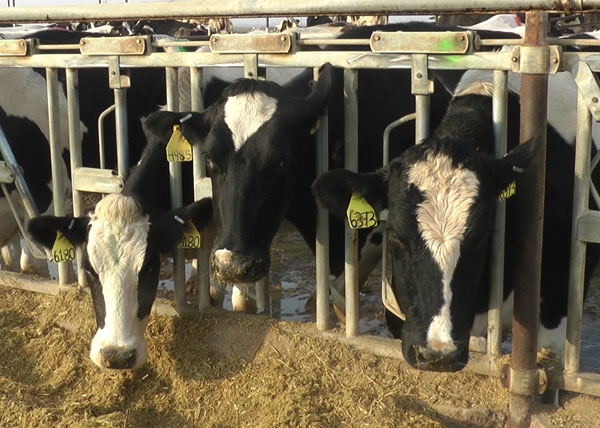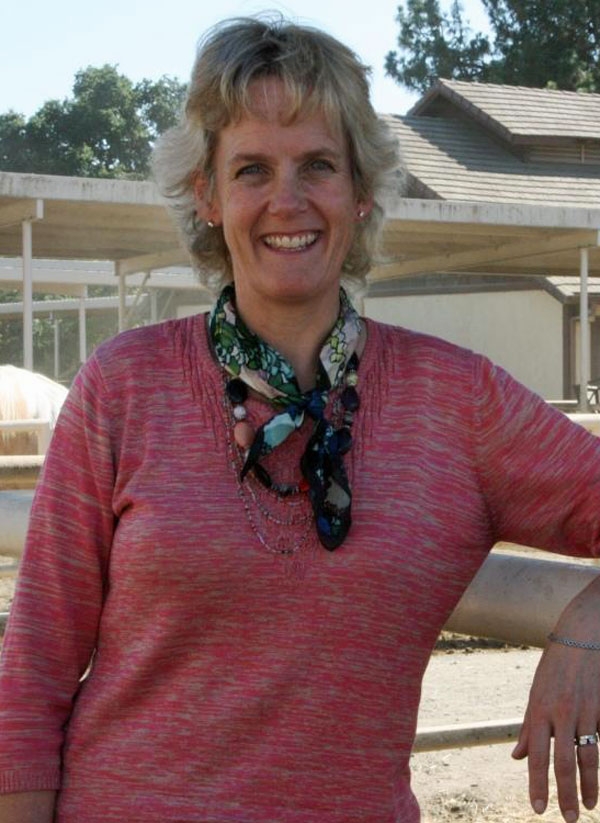Posts Tagged: genomics
Science will allow dairies to pick from a smorgasbord of genes for cow breeding
Conventional breeding of cattle over decades has resulted in significant positive impacts for dairies and the environment. With genomics, the future looks still brighter.
For the most part, dairy operators select cattle for breeding that have the highest genetic potential for milk production, health, structural soundness and fertility. The introduction in the 1940s of artificial insemination from bulls that were proven to father productive daughters resulted in dramatic changes to the industry, according to geneticist Alison Van Eenennaam, UC Cooperative Extension specialist with UC Agriculture and Natural Resources.
“In the U.S., we used to milk 26 million cattle, now there are 9 million, and despite that reduction we produce one and a half times more milk for American consumers,” said Van Eenennaam, who is based in the Department of Animal Science at UC Davis. “The carbon footprint of a glass of milk today is about one-third of what it was in the 1950s.”
Genomics does not involve genetically modified organisms (GMOs). It involves the sequencing and analysis of the cow genome. Mapping of the cow genome, completed in 2009, has provided scientists with information on the 3 billion base pairs on cattle DNA from which they can conduct research trials to tease out which pairs are responsible for which traits. The process is so complex that research will continue for decades, but progress is already reaping rewards for the dairy industry.
One of the current goals in dairy genomics is improving cattle fertility, or improving the number of cows that get pregnant on the first try. Research has found that there is an inverse relationship between milk production and fertility. Selection for increased milk production has resulted in cows with declining fertility.
“There's almost always an inverse correlation between production and reproduction,” said Van Eenennaam. “If you don't include fertility in your breeding program, it will decline as you select for more productive cows. Genomics allows us to make selection more balanced and include all of the traits that are of importance to dairy production.”
Scientists are looking for bulls with the genetic markers for fertility combined with the markers for high milk yield. The combination of markers are genotypes.
Identifying bulls with the optimal genotypes is the first step. Next, the producers must decide how to use the information, according to Joe Dalton, a geneticist at the Center for Reproduction Biology at the University of Idaho. Dalton is a member of a team that received a grant from USDA to spread the word about dairy genomics to producers around the U.S.
Dalton suggested four potential ways dairy operators can use information about dairy cattle genotypes to optimally manage the genetics of their herds:
- To sell the animals
- To make breeding decisions
- To identify an animal's parentage
- To make informed purchasing decisions
Van Eenennaam is working with cattle genomics to address the animals' susceptibility to respiratory disease. When cows catch cold, the viruses can weaken the immune system. Opportunistic bacterial infections can settle in the lungs and result in pneumonia, which requires expensive treatment with antibiotics and can even cause premature death.
“We will need to prevent these diseases in the future,” Van Eenennaam said. “Cattle that are sick with pneumonia are frequently treated with antibiotics. Breeding in resistance to respiratory disease will reduce that.”
Van Eenennaam and her collaborators took DNA samples from 1,000 California dairy calves suffering from respiratory disease and their immediate neighbors who remained healthy. They compared the DNA profiles of sick calves with healthy calves to identify regions in the genome that differed between the groups.
Her research has shown that 21 percent of susceptibility to respiratory illness can be attributed to the genetics of the calves.
“More than 100 genomic regions were significantly associated with respiratory disease,” Van Eenennaam said. “That supports the idea that many genes are associated with susceptibility to the disease.”
In time, respiratory disease susceptibility can be included in the index that producers consider when selecting the genetics of the cows they milk on their farms.
This research project is being funded by the USDA Agriculture and Food Research Initiative.
An initiative to enhance competitive and sustainable food systems is part of UC Agriculture and Natural Resources Strategic Vision 2025.
World Food Center at UC Davis will tackle global issues
When you think casually of “food,” you may think of your next meal or your favorite food. “World food” may broaden your thinking to include international cuisines, global hunger, or a growing population. But the academic fields related to food are numerous. Food is one of life’s basic necessities, and along with its associated issues it is essential to the health and well-being of everyone, whatever their locale, education, or income level.
The new World Food Center at UC Davis will take on a broad purview related to food, including sustainable agricultural and environmental practices, food security and safety, hunger, poverty reduction through improved incomes, health and nutrition, population growth, new foods, genomics, food distribution systems, food waste, intellectual property distribution related to food, economic development and new technologies and policies.
With rapid global population growth occurring on smaller amounts of arable land, coupled with the expected impacts of climate change on food production, understanding the sustainability of food into the future is critical.
The new center’s website notes, “The World Food Center at UC Davis takes a ‘big picture’ approach to sustainably solving humanity’s most pressing problems in food and health. By bringing together world-class scientists with innovators, philanthropists and industry and public leaders, the center will generate the kind of visionary knowledge and practical policy solutions that will feed and nurture people for decades to come.”
In establishing the World Food Center, UC Davis Chancellor Linda Katehi said, “We did this to fully capitalize on our depth and expertise as the world’s leading university for education, research and scholarship on all aspects of food, but especially the nexus between food and health.”
UC Davis is the top-ranked agricultural university in the world, and California is the major producer of vegetables and fruit in the nation. Tom Tomich, director of the Agricultural Sustainability Institute and professor in the Department of Environmental Science and Policy at UC Davis, says of the World Food Center’s location at UC Davis, “There’s no place else that has the right mix of educational programs, research facilities, and the engagement with the state.”
The major academic disciplines surrounding food are found at UC Davis — agriculture, the environment, medicine, veterinary medicine, engineering, social and cultural sciences, and management. More than 30 centers and institutes at UC Davis will be pulled together through the World Food Center. The combination of scholarship, leadership, and partnerships at UC Davis has already established the campus as a center for food-related science and outreach. This new center will reinforce that strength and broaden the university’s ability to tackle tough global issues related to food.
Although the founding director of the center has yet to be named, Josette Lewis, Ph.D., was recently appointed as the associate director of the World Food Center. Her background on international research and development for the U.S. Agency for International Development, and director of its Office of Agriculture, honed her skills to take on the World Food Center. It was at US AID that she worked on a major global hunger and food security initiative, establishing her expertise on issues related to global agricultural development and food security.
As the new World Food Center becomes fully developed, it will be well-positioned on campus to continue to solve the major global issues related to food that are a hallmark of UC Davis.
Additional information:
- World Food Center website
- UC Davis video on the World Food Center
- Key facts
- UC Davis Dateline article
- Sacramento Bee article



